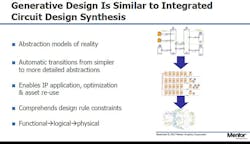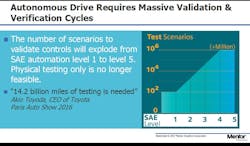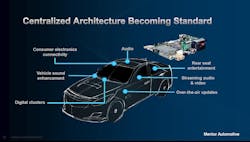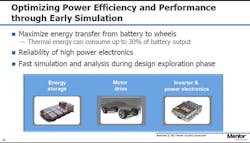Self-Driving Car Design: Following the Semiconductor Industry’s Lead
Opening the 17th edition of Mentor Graphics’ Integrated Electrical Solutions Forum for the automotive, commercial vehicle, and off-highway industry, Mentor’s CEO Walden C. (Wally) Rhines took on the subject of “Discontinuities in Automotive EE Design.”
Rhines suggested there are numerous parallels between the semiconductor industry and the automotive industry as it approaches the era of the self-driving car. “Throughout history, as I’ve observed it, people do not change their methodology for design unless they have to,” he said. “If they got something that works, they keep doing it. There’s a strong reluctance to adopt [something else] until the system we’re using stops working and then you have to adopt, and that’s basically what happened in the semiconductor industry.
“The complexity of chips grew at such a level that it wasn’t just difficult to do it in the old way—it was impossible,” he continued. “And so you had to adopt automation.”
Rhines said he expects the automotive industry to evolve in the same way—about 20 years after the semiconductor industry—by using what is being called generative design, an analogous function to what the semiconductor industry calls synthesis. Ultimately, he said, even traditionally manual things like wiring and harnesses will require an automated way of going from a functional description to a logical description, and finally to physical implementation.
Rhines noted that in the semiconductor industry, simulation was followed by a variety of other formal verification and informal verification capabilities, so that today it’s fairly routine to have designs with billions of transistors and yet have fully functional chips created on the first pass.
Just as a human couldn’t possibly design an integrated circuit with manual techniques, he said, you cannot verify a self-driving automotive system in the traditional way.
Rhines cited Toyota’s CEO Akio Toyoda, who said recently that to verify the electronics and algorithms of a driverless car would require driving it 14.2 billion miles. On top of that, Toyoda added, you would have to have a million different scenarios, different conditions of driving, and different encounters just to be sure that it met all the requirements. Driving 500 cars at 60 miles per hour, 24 hours a day, would take 54 years to run a million scenarios, Rhines noted.
As with electronic design automation, Rhines predicted virtualization will determine the winners for system design in autonomous vehicles “because it will be impossible not to adopt virtual design for a far greater percent of the design and verification process of vehicles in the future.” He characterized driver assistance as still at the stage of adding subsystem capabilities one at a time: “So we have cars that are getting RADAR, and cameras, and so on. And in general, they're being built up with their own independent software stacks, with their own processing of data.”
The Mentor chief cited reasons to believe that traditionally distributed systems in a vehicle are going to give way to a more centralized approach. Designers, he said, are looking at centralized processing to retain raw data so you can overlay Radar data, with LiDAR data and visual data, do sophisticated algorithmic processing, and apply artificial intelligence. In this way, you reduce the cost, eliminate software stacks, and use less local processing and lower-cost components.
As a specific example, Rhines mentioned infotainment, which developed in increments from digital radio, through GPS, and to a variety of human-machine interfaces, with each development having its own unique software stack—one on top of the other. But the overhead has “become enormous, so companies have had to rethink the overall architecture,” he said. These firms now are taking a more integrated approach.
“Thermal analysis is becoming more important,” Rhines said. “In a lot of cases people are looking at the thermal effects on efficiency of a vehicle…thermal energy is a big consideration. If you generate heat instead of useable power, you lose 30% of the battery output, and there’s all the reliability issues associated with having higher temperatures. “
If you lower the battery temperature by 10° from 30 to 20° centigrade, he added, “you can get a two to three-year increase in battery lifespan and the thermal efficiency can improve battery performance by 20%. Thermal simulation is the only way you’re going to find out what will happen because you just can’t physically test that many alternatives under that many sets of conditions.” Rhines emphasized the necessity of characterizing the motor drive, the IGBTs, the inverters, and the power electronics far in advance of making architectural decisions.
Rhines concluded his talk by saying that Just as integrated circuit design evolved from manual to computer-based virtual design, more and more of a vehicle will be designed and verified before building prototypes or subsystems. Accurate modeling of components and connectivity is required, he said, if you’re going to optimize system performance, cost, and other capabilities. And that includes multiple domains: electrical, physical, thermal, software, signal integrity, and so forth. “Those who master and apply virtual design and simulation, and verification and validation technology, will be the winners in this whole disrupted transition of the industry,” he concluded.







